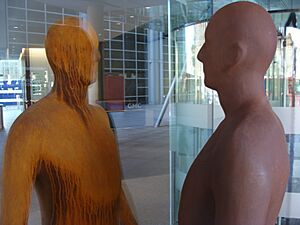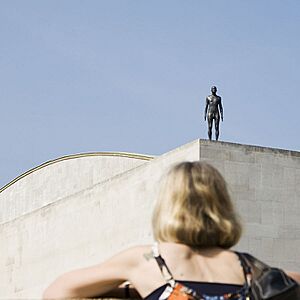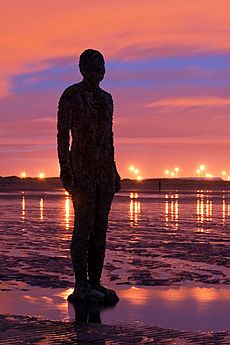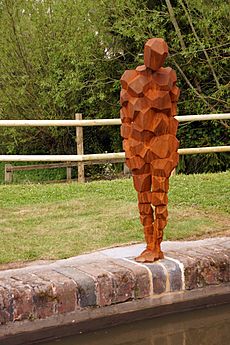Antony Gormley facts for kids
Quick facts for kids
Antony Gormley
|
|
|---|---|
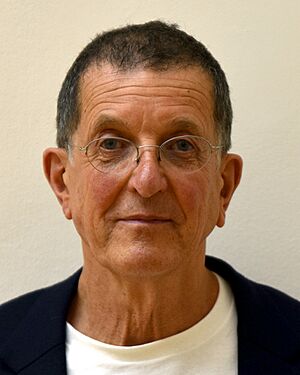
Gormley in 2024
|
|
| Born |
Antony Mark David Gormley
30 August 1950 Hampstead, London, England
|
| Education |
|
| Known for | Sculpture, Installation Art, Public Artworks |
| Spouse(s) |
Vicken Parsons
(m. 1980) |
| Awards |
|

Gormley's Sound II in the crypt beneath Winchester Cathedral.
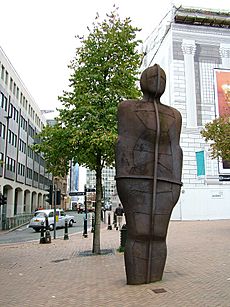
Iron: Man (1993), in its former location in Victoria Square, Birmingham. It has since been relocated, nearby.
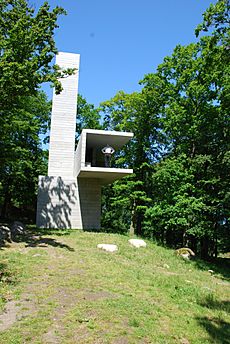
Antony Gormley and David Chipperfield's Sculpture for an objective experience of architecture (2008), Kivik Art Centre, Sweden

Untitled (for Francis) 1985 at the Tate Modern
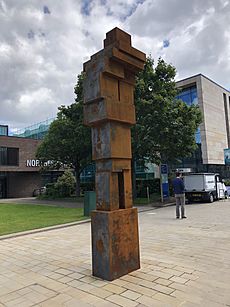
Clasp at Newcastle University, 2018.
|
Sir Antony Gormley (born August 30, 1950) is a famous British sculptor. He is known for creating large public artworks. Some of his most famous pieces include the Angel of the North, a huge sculpture in Gateshead, England. He also created Another Place with 100 figures on a beach near Liverpool, and Event Horizon, which placed many figures on city skylines.
Contents
Early Life and Education
Antony Gormley was born in Hampstead, London. He was the youngest of seven children. His mother was German, and his father had Irish roots. Gormley grew up in a wealthy family. His parents chose his initials, "AMDG," to mean "to the greater glory of God." This phrase comes from a Latin saying.
Gormley went to a boarding school called Ampleforth College. After that, he studied Archaeology, Anthropology, and Art History at Trinity College, Cambridge, from 1968 to 1971.
Travels and Early Art Ideas
Between 1971 and 1974, Gormley traveled to India and Sri Lanka. He wanted to learn more about Buddhism. When he came back to England, his travels inspired him to create one of his first artworks, Sleeping Place. For this piece, he draped a plaster-soaked sheet over a friend. The hollow shape looked like a body. It reminded him of people he saw sleeping in India, wrapped in cloths.
After his travels, Gormley continued his art studies in London. He attended Saint Martin's School of Art, Goldsmiths, University of London, and the Slade School of Fine Art. As a student, he often used natural materials like stone and wood in his art.
Antony Gormley's Art Career
Gormley's art career began with his first solo exhibition in 1981 at the Whitechapel Gallery. In this show, he displayed works that explored surfaces and inner structures. One piece, Natural Selection, featured everyday objects covered in lead. Another, Room, was an enclosure made from his own clothes.
Exploring the Human Body
Soon, Gormley started focusing on the human body. He made molds of his own body using plaster, then covered them in lead. These sculptures, like Three Ways: Mould Hole and Passage, explored the body as a space. Gormley wanted to show the body as a place, not just an object. He said his work tries to "materialise the place at the other side of appearance where we all live." His art aims to show a feeling or condition that all humans share.
In the 1990s, Gormley's hollow body sculptures became solid. He started casting them in iron, making heavy forms that take up space. One such work, Critical Mass II, included 60 life-sized sculptures in different positions. Gormley called it an "anti-monument to the victims of the 20th century." This artwork has been shown in many places around the world.
Large-Scale Installations
In 2006, Gormley created Asian Field. This huge artwork featured about 200,000 small clay figures. Around 300 Chinese villagers made these figures in just five days, using 100 tons of red clay. This project showed how art can involve many people.
In 2007, Gormley's Event Horizon was installed in London. It had 31 life-sized figures, cast from his own body. These figures were placed on top of buildings along the South Bank. Later, the same artwork was shown in New York City, São Paulo, and Hong Kong. It made people think about city life and how we relate to each other in big places.
In 2009, Gormley launched One & Other in Trafalgar Square, London. For this project, members of the public were chosen to stand on a famous empty stone plinth for one hour. It was a unique "living art" event that got a lot of attention.
Throughout the 2000s, Gormley also explored how the human body connects with buildings. He created "Blockworks" using steel and iron blocks. These sculptures replaced body parts with architectural shapes, reminding us of built environments.
Recent Works and Exhibitions
In 2014, Gormley was featured in a TV show that followed him and his team. They were preparing a new work called Expansion Field, which included 60 huge steel figures. This work was later shown in Switzerland.
In 2015, five life-sized sculptures called Land were placed in different parts of the UK. These were commissioned to celebrate the 50th anniversary of the Landmark Trust. One of these sculptures was knocked over by a storm.
In September 2015, Another Place celebrated its 10th anniversary at Crosby Beach. Gormley was happy to see how the sculptures had become part of the natural environment, even getting barnacles on them.
Gormley's first sculpture in New Zealand, Stay, was installed in 2015 and 2016. It included two identical cast-iron human figures placed in Christchurch.
In 2019, Gormley placed iron "bodyforms" on the ancient island of Delos in Greece. This was the first time a modern artist had an exhibition at this important historical site in over 5,000 years. He installed 29 sculptures that blended with the island's ancient ruins.
Also in 2019, the Royal Academy of Arts in London held a major exhibition of Gormley's works. It filled 13 galleries with his sculptures and drawings.
In 2022, a Gormley sculpture called Alert was installed at Imperial College London. That same year, he had exhibitions in Belgium, Germany, and the Netherlands.
In 2023, Gormley had several large exhibitions. Critical Mass was shown at the Musée Rodin in Paris, France. This was the first time a living artist was invited to show work throughout the entire museum. He also opened Body Politic in London, featuring new sculptures about movement and migration.
In 2024, Time Horizon, an installation of 100 cast iron sculptures, opened at Houghton Hall in Norfolk. Gormley also unveiled True, for Alan Turing at King's College, Cambridge. This sculpture, made from steel, honors the famous mathematician and computer scientist Alan Turing. Gormley said he wanted to create the best sculpture to honor a man who changed everyone's lives.
Awards and Recognition
Antony Gormley has received many awards for his art. He won the famous Turner Prize in 1994 for his work Field for the British Isles.
He became a Royal Academician in 2003. He was also a trustee of the British Museum from 2007 to 2015. He has received honorary degrees from several universities.
In 2011, Gormley won an award for his set design for a dance performance called Babel (Words). He also received the Obayashi Prize in 2012 and the Praemium Imperiale for sculpture in 2013.
Gormley was made a knight in 2014 for his contributions to the arts. This means he can be called "Sir Antony Gormley." In June 2025, he was appointed a Companion of Honour by King Charles III. This is a very special award.
In 2008, The Daily Telegraph newspaper ranked Gormley as one of the most powerful people in British culture.
Where to See His Art
Antony Gormley's sculptures are held in many important public and private art collections around the world. You can find his work in places like the Tate in London, the British Museum, the Centre Pompidou in Paris, the Uffizi Gallery in Florence, and the Museum of Contemporary Art, Los Angeles.
Personal Life
Antony Gormley is married to Vicken Parsons, who is also a successful artist. They met while studying art. They have three children.
Gormley supports Paintings in Hospitals, a charity that provides art for health and social care places.
In 2022, Gormley applied for German citizenship. He was able to do this because his mother was German.
Major Works by Antony Gormley
Here are some of Antony Gormley's most notable artworks:
- Bed (1981) – This piece was bought by the Tate Gallery.
- Sound II (1986) – Located in the crypt of Winchester Cathedral in England.
- Brick Man (1986) – A model for a proposed sculpture, now in Leeds City Art Gallery.
- Field (1991) – This artwork has been recreated many times.
- Iron:Man (1993) – Found in Victoria Square, Birmingham, England.
- Havmann (1995) – Located in Mo i Rana, Norway.
- Another Place (1997) – Permanently installed at Crosby Beach near Liverpool, England.
- Quantum Cloud (1999) – Located in Greenwich, London, England.
- Angel of the North (1998) – A very famous sculpture near Gateshead, England.
- Present Time (2001) – At Mansfield College, Oxford.
- Planets (2002) – At the British Library, London.
- Filter (2002) – Acquired by Manchester Art Gallery in 2009.
- Inside Australia (2003) – A permanent exhibition at Lake Ballard, Western Australia.
- Blind Light (2007) – Shown at the Hayward Gallery, London.
- Event Horizon (2007) – Displayed in London, New York City, São Paulo, and Hong Kong.
- Reflection II (2008) – Acquired by DeCordova Museum and Sculpture Park.
- One & Other (2009) – A public art project in Trafalgar Square, London.
- Another Time XI (2009) – A sculpture on top of Exeter College, Oxford.
- Horizon Field (2010–2012) – A sculpture installation in the Austrian Alps.
- Exposure (2010) – Located in Lelystad, Netherlands.
- Transport (2011) – In the Crypt of Canterbury Cathedral, England.
- Witness (2011) – On the piazza of the British Library, London.
- Stay (2015/16) – Located in Christchurch, New Zealand.
- DAZE IV (2016) – At the University of Cambridge.
- Sight (2019) – An exhibition on Delos Island, Greece.
- Alert (2022) – At Imperial College London.
- True, for Alan Turing (2024) – At King's College, Cambridge.
See also
 In Spanish: Antony Gormley para niños
In Spanish: Antony Gormley para niños


